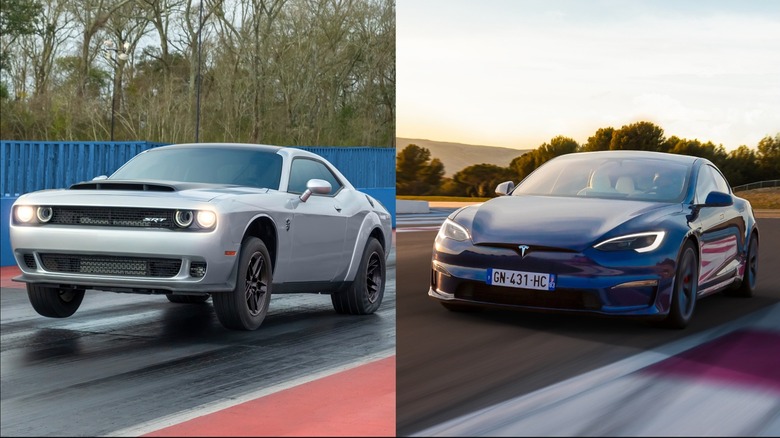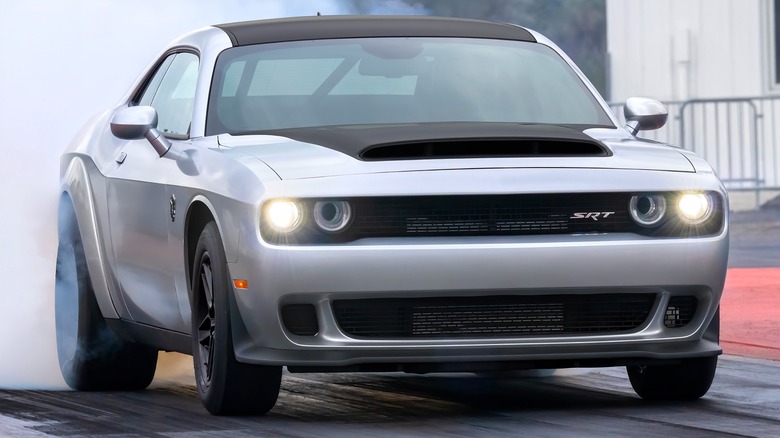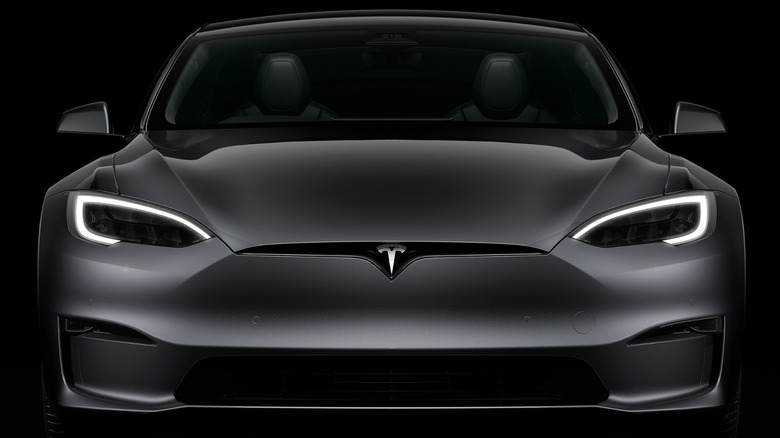Is The Dodge Challenger SRT Demon 170 Faster Than A Tesla? A Look At How They Compare
What do you get when you pit a high-output Hellcat 6.2-liter supercharged V8 equipped Dodge against the first Tesla EV to get three electric motors? You get an absurdly over-the-top matchup with some surprising results.
Officially barred from competing in National Hot Rod Association events, the 2023 Dodge Challenger Demon 170 is widely considered the automaker's muscle car magnum opus. With an incredible 1,025 horsepower and 945 pound-feet of torque, this drag strip monster can achieve a reported 0-60 mph time of 1.66 seconds, but this comes with some caveats. In addition, Dodge states this muscle car can pull off an 8.91-second quarter-mile reaching just over 151 mph. It begs the question is the Dodge Demon 170 even street legal?
With a total of three electric motors, the Tesla Model S Plaid outputs a staggering combined 1,020 horsepower and even more torque than the Dodge at 1,050-pound feet. This impressive output is only one of the best features of the Tesla Plaid. Track tests showcase this robust EV can manage 0–60 mph in just 1.98 seconds. As far as driving a quarter-mile distance, the Plaid can do it in 9.23 seconds according to Tesla. So, the Dodge Challenger Demon 170 is slightly faster than the Tesla Model S Plaid, right? Not so fast, these figures are only telling part of the story.
These performance figures are only possible under specific conditions
Is the Challenger Demon 170 quicker than the Tesla? It could be, but you need to fill it with E85 fuel, use a prepped drag strip surface that includes rosin (a hardened form of resin which is derived from certain trees), rubber and other traction compounds. In addition, you'll also benefit from air temperatures around 60 degrees Fahrenheit, track surface temperatures around 70 degrees Fahrenheit, with zero rain, calm winds, and low humidity.
Motor Trend was able to get the Tesla Model S Plaid under a 2-second 0-60 mph run, but only by following specific guidance from the EV maker. For example, Tesla required a specific raceway for the tests, and a special compound called VHT (TrackBite) was required on the surface for enhanced traction. The vehicle was also set in "Drag Strip Mode," which takes a quite a few minutes to full engage. This mode shouldn't be used during everyday driving.
Who's driving also has a massive impact on what a vehicle can do on the track. While the average Joe may think they can set track records behind the wheel, only an expert driver has the experience and skill to pull out every ounce of horsepower and torque for top times.
So, what about more realistic performance figures?
Even without the aid of a prepped track or ideal conditions, both the Dodge and Tesla are remarkably fast. One expert review estimated that a more realistic 0-60 mph time for the Demon 170 would be 2.2 seconds. If accurate (Dodge hasn't published official 0-60 figures for the Demon 170), it would be one-tenth of a second slower than the real-world Model S Plaid figure of 2.1 seconds tested by Car and Driver.
In terms of a quarter-mile, one Demon 170 owner attempted to match or beat Dodge's official figure, 8.91-second quarter-mile reaching just over 151 mph. However, his time slip showed his best run was 9.3 seconds at 147.73 mph. Another enthusiast managed to get a 9.1-second quarter-mile run at 148.22 mph. The official Dodge figures remained elusive.
Meanwhile, the Tesla Model S Plaid, when tested by Car and Driver, couldn't quite reach its official performance figures, but it did get close with a 9.4-second quarter-mile at 151 mph. Ultimately, when the numbers come down to tenths-of-a-second between the two cars, which one is faster all comes down to the day, driver, track, and possibly, luck.


